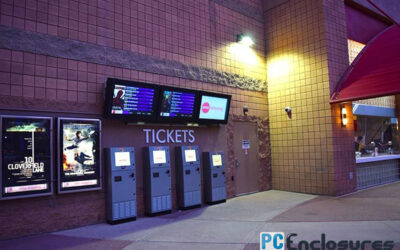Placing a TV or PC (LED Display) in an outdoor location subject to direct sunlight presents technical challenges. The TV typically must be placed in a protective enclosure that will prevent ingress of dust, dirt, and water (see link to NEMA 4). Placing a TV inside an enclosure that utilizes a transparent window for viewing can cause significant heat management problems when the window is exposed to direct sunlight.
When sunlight (radiation) passes through the window of a TV enclosure, the interior heats in the same fashion as a greenhouse. Sunlight passes through the window and is then absorbed onto internal surfaces and converted into infrared energy (heat). Infrared energy has a longer wavelength than visible light and cannot easily pass back out of the window, therefore “trapping” heat inside. This is a familiar phenomenon in closed cars in the summer. This experimenter showed how to bake cookies on the dashboard of his car Scott Sutherland, Science Writer.
At PC Enclosures, we experimented with an enclosure designed to house a 55 inch TV. On a sunny spring day, we placed the enclosure on the ground with the window facing up toward the sun. We placed thermometers inside and outside of the enclosure and timed the internal heating of the enclosure. The outside temperature was measured at 73oF. When the window was uncovered and exposed to sunlight, the internal temperature rose to 128oF (55oF temperature rise) in 30 minutes. This experiment carried out in mid-summer can lead to internal temperatures over 170oF.
Regular TVs typically have a high temperature specification of about 104oF. At temperatures above that, the screen will begin to “black out”. Blacked out LED TV screens will recover back to normal once they have cooled, but multiple black outs of a screen can damage the screen. Polycarbonate windows can warp in direct sunlight at internal enclosure temperatures above 125oF. These windows can normally stand temperatures up to 150oF, but doing so is risky. Also, at temperatures above 150oF, some TV electronics could suffer permanent damage. Some outdoor rated TVs can handle temperatures of 125oF to 130oF before they black-out.
Cooling calculations for a windowed enclosure are complex. For a detailed discussion see Thermal Management of Displays/Signage in Outdoor Enclosures. For direct sunlight applications, two methods of cooling are typically used: air curtain and air conditioning.
Air Curtain
An air curtain design can be employed to sweep heat from a gap between the TV screen and the viewing window. Fresh air is drawn from outside the enclosure and blown by fans across the front of the TV screen. The air is heated by sunlight, but is continually exchanged with fresh, cooler air from outside. Once the air passes across the screen, it is then blown out of the enclosure by additional fans. In this cooling method, the higher the air flowrate, the lower the temperature rise inside the enclosure. Typical air curtain designs seek to keep the internal temperature of the enclosure at about 10oF above the outside, ambient temperature. It is important to note that an air curtain cannot cool the enclosure to a temperature below the outside ambient temperature.
Air Conditioning
TV and a PC enclosure can be fitted with an air conditioning system to cool the enclosures as needed. This is a relatively expensive solution, but also provides a robust operation that can handle direct sunlight in hot climates. Companies such as Ice Qube provide enclosure specific air conditioners that can be sized to the specific application. These air conditioners can also be rated for NEMA 12, 4, 4X and IP 66.
Conclusion
Care should be employed when considering an outdoor TV enclosure exposed to direct sunlight. Doing so without a heat management solution such as an air curtain or air conditioning will likely result in damage to the TV and polycarbonate window.




